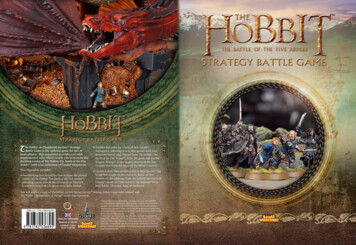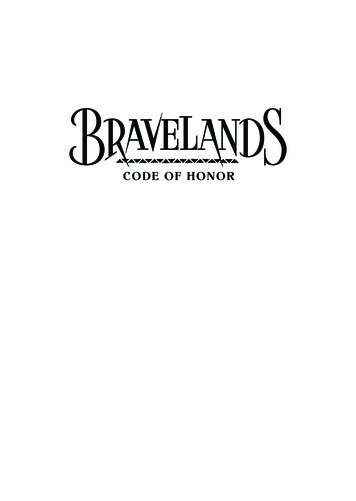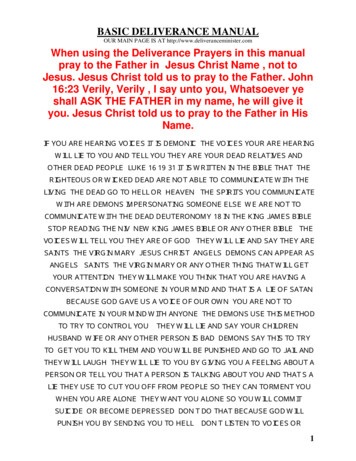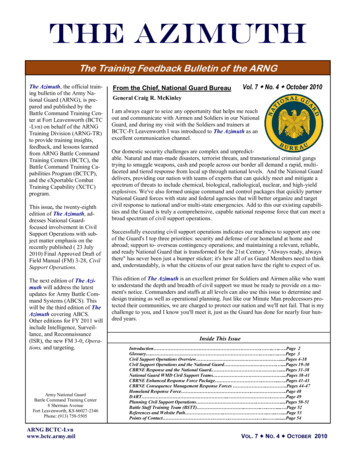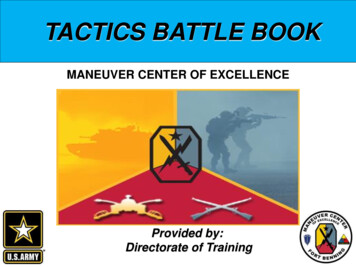
Transcription
TACTICS BATTLE BOOKMANEUVER CENTER OF EXCELLENCEProvided by:Directorate of Training1
REFERENCESUnified Land Ops:ADRP 3-0Tactics:FM 3-90Operational Termsand Graphics:ADRP 1-02The Infantry RifleCompany:FM 3-21.10Infantry Platoon & Squad:ATP 3-21.8The Operations Process: ADRP 5-0The Commander and Staff Officer guide: ATTP 5-0.12
SUMMARY Unified Land Operations– –Decisive Action Tasks OFFENSIVE OPERATIONS OffensiveDefensiveStabilityDefense Support of CivilAuthorities–Elements of the Attack Support by fireBreachAssaultCordon/SecurityReserveTYPES OF OFFENSIVE TASKSELEMENTS OF COMBAT POWER–– Theory of Machine Gun FireClasses of Fire with respect toGroundTargetGunDeliberateHastySpecial poEnvelopmentTurning MovementInfiltrationPenetrationFrontal AttackFlankTROOP LEADING rogradeCHARACTERISTICS ExploitationPursuitFORMS OF MANEUVER TYPES Search and AttackCordon and SearchCHARACTERISTICS –Attack––– DEFENSIVE OPERATIONSMovement to Contact–– –FlexibilityDisruptionMass & ConcentrationPreparationSecurityManeuverOperation in DepthTECHNIQUES Defend in SectorDefend from a Battle PositionDefend a Strong PointPerimeter DefenseLinearNon-linearReverse SlopeCOMBAT ORDERS Operations orderWarning orderFragmentary orderReceive the missionIssue a warning orderMake a tentative planInitiate movementConduct reconnaissanceComplete the planIssue the orderSupervise and Refine3
Acronyms and AbbreviationsAASLT – Air assaultABN – AirborneADA – Air defense artilleryAI – Area of interestAO – Area of operationAOA – Avenue of approachAT- Anti TankAPOD – Aerial port of debarkationBPT- Be prepared toBMNT – Begin morning nautical twilightBN – BattalionCATK – CounterattackEENT – End of evening nautical twilightFO – Forward observerFPF- Final protective firesFSO – Fire support officerHE – High explosiveINTEL – IntelligenceIOT – In order toIVO- In vicinity ofIV lines – Intervisibility lineNAI- Named area of interestNFA – No-fire areaNLT – No later thanOPORD – Operation orderO/O – On orderOP – Observation postRFL – Restricted fire lineSBCT- Stryker Brigade CombatTeamvic – VicinityWFF – Warfighting FunctionsW/O – WithoutWP – White phosphorus4
TASKS AND PURPOSESTactical Tasks (ADRP 3-90, Fig 2-1)Actions By Friendly ForceAttack by isengagementExfiltrateFollow and AssumeFollow and SupportOccupyReduceRetainSecureSeizeSupport By FireEffects on oses(In order r’s IntentA clear and concise expression of the purpose of the operation and the desiredmilitary end state that supports mission command, provides focus to the staff, andhelps subordinate and supporting commanders act to achieve the commander’sdesired results without further orders, even when the operation does not unfold asplanned. (ADP 3.0, glossary-2)Tactical tasks are specific activitiesperformed by the unit while it isconducting a form of tacticaloperation or a choice of maneuver.The title of each task can also beused as an action verb in the unit’smission statement to describe actionsduring the operation. Tasks shouldbe definable, attainable, andmeasurable.PURPOSEA simple, clearly stated purpose tellssubordinates the reason the unit isconducting the mission.FM 3-21.8 p5-2,5-3Decisive PointATTACK BY FIRE: A tactical mission task in which a commander uses directfires, supported by indirect fires, to engage an enemy without closing with him to destroy,suppress, fix, or deceive him. (ADRP 1-02 pg. 1-4)BLOCK: A tactical mission task that denies the enemy access to an area orprevents his advance in a direction or along an avenue of approach. 2. An obstacle effect thatintegrates fire planning and obstacle effort to stop an attacker along a specific avenue ofapproach or to prevent him from passing through an engagement area. See also contain;disrupt; fix; turn. (ADRP 1-02 pg.1-5)A geographic place, specifickey event, critical factor, orfunction that, when actedupon, allows commanders togain a marked advantage overan adversary.(ADRP 3-0, p4-4)5
TACTICAL MISSION TASKSBREACH - A tactical mission task in which the unit employs all available means to break through or securea passage through an enemy defense, obstacle, minefield, or fortification. (FM 3-90) also (ADRP 1-02 pg.1-5)BYPASS - A tactical mission task in which the commander directs his unit to maneuver around an obstacle,avoiding combat with an enemy force. (FM 3-90) (ADRP 1-02 pg.1-5)CANALIZE -A tactical mission task in which the commander restricts enemy movement to a narrow zoneby exploiting terrain coupled with the use of obstacles, fires, or friendly maneuver. (FM 3-90) also (ADRP 1-02 pg.1-6)CLEAR - A tactical mission task that requires the commander to remove all enemy forces and eliminateorganized resistance in an assigned area. (FM 3-90) or (ADRP 1-02 pg. 1-7)CONTAIN - To stop, hold, or surround the forces of the enemy or to cause the enemy to center activity ona given front and to prevent his withdrawing any part of his forces for use elsewhere. (ADRP 1-02 pg. 1-9)CONTROL - A tactical mission task that requires the commander to maintain physical influence over a specifiedarea to prevent its use by enemy or to create conditions necessary for successful friendly operations. (ADRP 1-02pg 1-10)DEFEAT - A tactical mission task that occurs when an enemy force has temporarily or permanently lost thephysical means or the will to fight. The defeated force’s commander is unwilling or unable to pursue his adoptedcourse of action, thereby yielding to the friendly commander’s will and can no longer interfere to a significantdegree with the actions of friendly forces. Defeat can result from the use of force or the threat of its use.(ADRP 1-02 pg. 1-12)DESTROY -1. A tactical mission task that physically renders an enemy force combat-ineffective until it isreconstituted. 2. To damage a combat system so badly that it cannot perform any function or be restored to ausable condition without being entirely rebuilt. (ADRP 1-02 pg. 1-13)6
TACTICAL MISSION TASKSDISENGAGE- A tactical mission task where a commander has his unit break contact with the enemy to allow theconduct of another mission or to avoid decisive engagement. (ADRP 1-02 pg.1-13)DISRUPT - A tactical mission task in which a commander integrates direct and indirect fires, terrain, andobstacles to upset an enemy's formation or tempo, interrupt his timetable, or cause his forces to commitprematurely or attack in piecemeal fashion. (ADRP 1-02 pg. 1-13)FIX -1. A tactical mission task where a commander prevents the enemy from moving any part of his forcefrom a specific location for a specific period of time. 2. An engineer obstacle effect that focuses fire planning andobstacle effort to slow an attacker's movement within a specified area, normally an engagement area.(ADRP 1-02 pg. 1-17)FOLLOW AND ASSUME - A tactical mission task in which a second committed force follows a forceconducting an offensive operation and is prepared to continue the mission if the lead force is fixed, attrited, orunable to continue. (ADRP 1-02 pg 1-17)FOLLOW AND SUPPORT - A tactical mission task in which a committed force follows andsupports a lead force conducting an offensive operation. (ADRP 1-02 pg 1-17)INTERDICT - A tactical mission task where the commander prevents, disrupts, or delays the enemy'suse of an area or route. (ADRP 1-02 pg. 1-22)ISOLATE - A tactical mission task that requires a unit to seal off – both physically and psychologically –an enemy from his sources of support, deny him freedom of movement, and prevent him from having contact withother enemy forces. (ADRP 1-02 pg 1-22)7
TACTICAL MISSION TASKSNEUTRALIZE - A tactical mission task that results in rendering enemy personnel or material incapable ofinterfering with a particular operation. (ADRP1-02 pg 1-26)OCCUPY - A tactical mission task that involves moving a friendly force into an area so that it can controlthat area. Both the forces movement to and occupation of the area occur without enemy opposition. (FM 1-02 pg1-27)REDUCE - A tactical mission task that involves the destruction of an encircled or bypassed enemy force.(ADRP 1-02 pg 1-31)RETAIN - A tactical mission in which the commander ensures that a terrain feature controlled by a friendlyforce remains free of enemy occupation or use. (ADRP 1-02 pg 1-32)SECURE - A tactical mission task that involves preventing a unit, facility, or geographical location frombeing damaged or destroyed as a result of enemy action. (ADRP 1-02 pg 1-33)SEIZE - A tactical mission task that involves taking possession of a designated area by usingoverwhelming force. (ADRP 1-02 pg 1-33)SUPPORT BY FIRE - A tactical mission task in which a maneuver force moves to a position where it canengage the enemy by direct fire in support of another maneuvering force. (ADRP 1-02 pg.1-34)SUPPRESS - A tactical mission task that results in temporary degradation of the performance of a force orweapons system below the level needed to accomplish its mission. (ADRP 1-02 pg 1-35)TURN - A tactical mission task that involves forcing an enemy element from one avenue of approach ormovement corridor to another. (ADRP 1-02 pg 1-38)8
GLOSSARY OF TERMS AND CONCEPTSAMBUSH- An ambush is a form of attack by fire or other destructive means from concealed positions on amoving or temporarily halted enemy. (ADRP 1-02 pg 1-2)ATTACK- An attack is an offensive operation that destroys or defeats an enemy force, seizes and secures terrainand or both. (ADRP 1-02 pg.1-4)CENTER OF GRAVITY(COG) - That characteristic, capability or locality from which a force derives its freedom ofaction, strength or will to act. (ADRP 1-02 pg 1-6)COMMANDER’S CRITICAL INFORMATION REQUIREMENT(CCIR) - The information and intelligencerequirements for which a commander has an anticipated and stated priority in planning and decision-making.(ADRP 1-02 pg 1-8)COUNTERATTACK - Attack by part or all of a defending force against an enemy attacking force, for such specificpurposes as regaining ground lost, or cutting off or destroying enemy advance units, and with the generalobjective of denying to the enemy the attainment of the enemy’s purpose in attacking. In sustained defensiveoperations, it is undertaken to restore the battle position and is directed at limited objectives. (ADRP 1-02 pg 1-10)COUNTERMOBILITY OPERATIONS- Those combined arms activities that use or enhance the effects of naturaland man-made obstacles to deny an adversary freedom of movement and maneuver. (ADRP 1-02 pg. 1-10)COVER- (Army) 1. Protection from the effects of fires. 2. A security task to protect the main body by fighting togain time while also observing and reporting information and preventing enemy ground observation of and directfire against the main body. (ADRP 1-02 pg. 1-11)9
DECISIVE OPERATION - The operation that directly accomplishes the mission. ADRP 1-02 pg 1-12)SHAPING OPERATION - An operation that establishes conditions for the decisive operation throught effects onthe enemy, other actors, and the terrain. (ADRP 1-02 pg 1-34)SUSTAINING OPERATION - Operations at any echelon that enables the decisive operation or shapingoperations by generating and maintaining combat power. (ADRP 1-02 pg 1-36)DECISIVE TERRAIN- is key terrain whose seizure and retention is mandatory for successful missionaccomplishment. (ADRP 1-02 pg 1-12)DECISION POINT – A point in space and time when the commander or staff anticipate making a key decisionconcerning a specific course of action. (ADRP 1-02 pg 1-11)DECISIVE POINT – A graphic place, specific key event, critical factor , or function that, when acted upon, allowscommanders to gain a marked advantage over an adversary or contribute materially to achieving success(ADRP1-02 pg. 1-2)DEMONSTRATIO N- An attack or show of force on a front where a decision is not sought, made with the aim ofdeceiving the enemy. 2. (DOD only) In military deception, a show of force in an area where a decision is notsought; made to deceive an adversary. It is similar to a feint but no actual contact with the adversary is intended.(Army) 1. A form of attack designed to deceive the enemy as to the location or time of the decisive operation by adisplay of force. Forces conducting a demonstration do not seek contact with the enemy. 2. In stability operationsand support operations, an operation by military forces in sight of an actual or potential adversary to show militarycapabilities.10
END STATE- The set of required conditions that defines achievement of the commander's objectives. See ADRP3-0.ESSENTIAL ELEMENT OF FRIENDLY INFORMATION (EEFI) –the enemy, would subsequently compromise, lead to failure, or limit success of the operation and thereforeshould be protected from enemy detection. (ADRP 5-0)EXPLOITATION - An offensive operation that usually follows a successful attack, to take advantage of aweakened or collapsed enemy defense. Its purpose is to prevent reconstitution of enemy defenses, to preventwithdrawal, and to secure deep objectives. (ADRP 1-02)FEINT: A form of attack used to deceive the enemy as to the location or time of the actual decisiveoperation. Forces conducting a feint seek direct contact with the enemy but avoid decisive engagements. (ADRP1-02)FRIENDLY FORCES INFORMATION REQUIREMENTS (FFIR) - Information about the activities or capabilities ofown or adjacent units.(ADRP 5-0)INTELLIGENCE PREPARATION OF THE BATTLEFIELD (IPB) - The systematic, continuous process ofanalyzing the threat and environment in a specific geographic area. IPB is designed to support the staff estimateand military decision making process. Most intelligence requirements are generated as a result of the IPBprocess. (FM 2-01.3)KEY TERRAIN - Any locality, or area, the seizure or retention of which affords a marked advantage to eithercombatant. (See FM 2-01.3.)MISSION STATEMENT– A short sentence or paragraph that describes the organization's essentialtask(s), purpose, and action containing the elements of who, what, when, where, and why. See(ADRP 5-0)MOVEMENT TO CONTACT - A form of the offensive designed to develop the situation and to establish orregain contact. (ADRP 3-90)NAMED AREA OF INTEREST (NAI) -The geographical area where information that will satisfy a specificinformation requirement can be collected. Also called NAI. (ADRP 1-02)OBJECTIVE -A location on the ground used to orient operations, phase operations, facilitatechanges of direction, and provide for unity of effort. (ADRP 3-90)11
PENETRATION -A form of maneuver in which an attacking force seeks to rupture enemy defenseson a narrow front to disrupt the defensive system. (FM 3-90)PRIORITY INTELLIGENCE REQUIREMENT(PIR)–An intelligence requirement, stated as a priority forintelligence support, that the commander and staff need to understand the adversary or the operationalenvironment (FM 2-01.3)PURSUIT- A form of offensive operation designed to catch or cut-off a hostile force attempting to escape, with theaim of destroying it. (ADRP 3-90)RAID - (DOD, NATO) An operation, usually small scale, involving a swift penetration of hostile territory to secureinformation, confuse the enemy, or to destroy installations. It ends with a planned withdrawal upon completion ofthe assigned mission. See (FM 3-90)RELIEF IN PLACE - An operation in which, by direction of higher authority, all or part of a unit is replaced in anarea by the incoming unit. The responsibilities of the replaced elements for the missions and assigned zone ofoperations are transferred to the incoming unit. The incoming unit continues the operation as ordered.(FM 3-90)RETROGRADE - An organized movement to the rear, or away from the enemy. It may be forced by the enemy,or made voluntarily. Such movements may be classified as withdrawal, retirement, or delaying operations.(ADRP 1-02)RISK MANAGEMENT– The process of identifying, assessing, and controlling risks arising fromoperational factors and making decisions that balance risk cost with mission benefits. Also called RM. See FM 519 and ADRP 5-0.SECTOR OF FIRE - A defined area, which is required to be covered by the fire of individual weapons or crewserved weapons of a unit. (ADRP 1-02)SUPPRESS -1. A tactical mission task that results in temporary degradation of the performance of a force orweapons system below the level needed to accomplish the mission. (FM 3-90)12
GRAPHIC CONTROL MEASURESCONTROL MEASURE– A means of regulating forces or warfighting functions. (ADRP 6-0)ASSAULT POSITION: That position between the line of departure (LD) and the objective in an attackfrom which forces assault the objective. Ideally, it is the last covered and concealed position before reaching theobjective.ASSEMBLY AREA: An area in which a command is assembled to prepare for further action.ATTACK POSITION: The last position occupied or passed through by the assault echelon beforecrossing the line of departure (LD).AXIS OF SHAPING/SUPPORTING ATTACK (GROUND): The axis of a shaping operationdesignates thegeneral area through which the unit’s conducting a ground shaping operationmust move the bulk of their combat power.AXIS OF MAIN ATTACK (GROUND): The axis of a decisive operation designates thegeneralarea through which the unit’s conducting a ground decisive operation must move the bulk of theircombat power.BATTLE POSITION (BP): A defensive location oriented on the most likely enemy avenue ofapproach from which a unit may defend.BOUNDARY: A control measure normally drawn along identifiable terrain features and used todelineate areas of tactical responsibility between adjacent units and higher headquarters to the rear of subordinateunits. Within their boundaries, units may maneuver within the overall plan without close coordination withneighboring units unless otherwise restricted. Direct fires may be placed across boundaries on clearly identifiedenemy targets without prior coordination, provided friendly troops are not endangered.13
CHECKPOINT: A predetermined point on the ground used to control movement and tactical maneuver.CONTACT POINT: In land warfare, a point on the terrain, easily identifiable, where two or more unitsare required to make contact.COORDINATING POINT: A control measure that indicates a specific location for the coordination offires and maneuver between adjacent units. They are usually indicated whenever a boundary crosses the forwardedge of the battle area (FEBA), and may be indicated when a boundary crosses phase lines (PL’s) used to controlsecurity forces.DIRECTION OF MAIN ATTACK: A specific direction or route that the main attack or center of mass ofthe unit main body of the force will follow. The unit is restricted, required to attack as indicated, and is notnormally allowed to bypass the enemy. The direction of attack is used primarily in counterattacks or to ensure thatsupporting attacks make maximum contribution to the main attack. Direction of attack is a more restrictive controlmeasure than axis of advance, and units are not free to maneuver off the assigned route. It is usually associatedwith infantry units conducting night attacks, or units involved in limited visibility operations, and in counterattacks.FINAL PROTECTIVE FIRE (FPF): An immediately available preplanned barrier of direct andindirect fire designed to provide close protection to positions and installations by impeding enemy movementacross defensive lines, battle positions or areas.FINAL PROTECTIVE LINE (FPL): A line of fire selected where an enemy assault is to be checked byinterlocking fire from all available weapons and obstacles.FORWARD EDGE OF THE BATTLE AREA (FEBA): The foremost limits of a series of areas in groundcombat units are deployed, excluding the areas in which the covering force or screening forces are operating. It isdesigned to coordinate fire support, the positioning of forces, or the maneuver of units.14
FORWARD LINE OF OWN TROOPS (FLOT): A line that indicates the most forward positions of forcesin any kind of military operation at a specific time. It normally identifies the forward location of covering andscreening forces.LIMIT OF ADVANCE (LOA): An easily recognized terrain feature beyond which attacking elements willnot advance.LCLCLINE OF CONTACT (LC): A general trace delineating the location where two opposing forces areengaged.LINE OF DEPARTURE (LD): A line designated to coordinate the departure of attack elements,commitment of attack units or scouting elements at a specific time.LINE OF DEPARTURE IS THE LINE OF CONTACT (LD/LC): The designation of forward friendly positions asthe LD when opposing forces are in contact.OBJECTIVE: The definite terrain feature, the seizure and/ or holding or which is essential to thecommander’s plan.PASSAGE POINT (PP): A specifically designated place where units will pass through one anothereither in an advance or withdrawal. It is located where the commander desires subordinate units to physicallyexecute a passage of lines.PHASE LINE (PL): A line used for control and coordination of military operations, usually arecognizable terrain feature extending across the sector or zone of action. Units normally reportcrossing PHASE LINE’S, but do not halt unless specifically directedPRINCIPAL DIRECTION OF FIRE (PDF): The direction of fire assigned or designated as the maindirection in which a weapon will be oriented. It is selected on the enemy, mission, terrain, andweapons capability.15
PROBABLE LINE OF DEPLOYMENT (PLD): A line selected on the ground, usually the lastcovered and concealed position prior to the objective and forward of the line of departure, where attacking unitsdeploy prior to beginning an assault; it is generally used under conditions of limited visibility.RALLY POINT: An easily identifiable point on the ground at which units can reassemble, and/ orreorganize if they become disbursed.RELEASE POINT (RP): A well defined point on a route at which the elements composing a columnreturn under the authority of their respective commanders, each one of these elements continuing its movementtowards its own appropriate destination.START POINT (SP): A well-defined point on a route at which movement of vehicles begins to be undercontrol of the commander of this movement. It is at this point that the column is formed by the successive passing,at an appointed time, of each of the elements composing the column.STRONGPOINT (SP): A defensive position, usually strongly fortified and heavily armed with automaticweapons, around which other positions are grouped for its protection. These positions require extensive engineereffort for obstacles and survivability positions, and are positioned to control or block an avenue of approach.Normally, command and control, aid stations, and critical supply stockpiles will be dug-in with overhead protection.Trenches and other protective constructions will be done to protect soldiers and weapons from damage duringassault by mounted and dismounted forces.TARGET REFERENCE POINT (TRP); An easily recognizable point on the ground (either natural orman-made) used to initiate, distribute, and control fires. TRPs can also designate the center of an area where thecommander plans to distribute or converge the fires of all his weapons rapidly. They are used by task force andbelow, and can further delineate sectors of fire within an engagement area. TRPs are designated using thestandard target symbol and numbers issued by the fire support officer. Once designated, TRPs also constituteindirect fire targets.16
OPERATIONAL OVERLAY LABELING REQUIREMENTSOVERLAY / OP NAMECLASSIFICATIONMAP 1:50 000KOSOVOUNCLASSIFIEDOP NCE82POINTNORTHPOINTN08UNCLASSIFIEDAUTHORLT I.M.GOOD230900ZAUG07DTGCLASSIFICATION17
Field123456789101112131415Description of amplifier fieldsDescriptionIndicates whether the unit is reinforced, detached, or both.An accepted code that shows the country indicator.A unique alphanumeric designation that identifies the unit being displayed.Note: For those units designated under the United States Army Regimental System (USARS) (formerly knownas the Combat Arms Regimental System [CARS]), both the battalion (or squadron) and traditional regimentalnumbers are shown. To avoid confusion with different levels of command, both numerical designations of theUSARS units are always written together and separated by a dash (–) rather than a slash (/). AR 600–82provides a listing of USARS units. The dash (–) is only used between the battalion and the regiment. The slash(/) is used between all other levels of command. Example: A/6–37/2 (Battery A, 6th Battalion, 37th FieldArtillery, 2d Infantry Division) or B/1–7/1/1 (B Troop, 1st Squadron, 7th Cavalry Regiment, 1st Brigade, 1stCavalry Division)Number or title of the next higher formation of the unit being displayed.Free text staff comments for information required by the commander.Echelon indicator of the symbol. (See table 4-5.)Quantity that identifies the number of items present.Task force amplifier placed over the echelon. (See table 4-6.)Feint or dummy indicator shows that the element is being used for deception purposes.Note: The dummy indicator appears as shown in figure 3-1 and can be used for all framed symbolsets. For control measures, it is a control measure symbol used in conjunction with other controlmeasures. (See table 8-6 for feint or dummy symbols.)Headquarters staff indicator identifies symbol as a headquarters. (See figure 4-2.)The direction of movement arrow indicates the direction the symbol is moving or will move.The offset location indicator without the arrow is used to denote precise location of units or todeclutter multiple unit locations, except for headquarters. (See figure 4-1.)Combat effectiveness of unit or equipment displayed.Mobility indicator of the equipment being displayed. (See figure 5-1 and table 5-3.)Indicates what type of headquarters element is being displayed. (See table 4-8.)Denotes enemy symbol. The letters “ENY” are used when color red is not used.16An alphanumeric designator for displaying a date-time group (DDHHMMSSZMONYYYY) or“O/O” for on order.16-1Used with 16 for displaying a date-time group for a from-to specified time period.17Identifies unique designation for type of equipment.18Denotes the location in latitude and longitude or grid coordinates.18
ADRP1-02 Page 3-4 Digital Page 7219
MILITARY SYMBOLSUNIT SIZE GRAPHIC NSTALLATIONSSQUADFRIENDSECTIONCOMPANY / BATTERY / TROOPBATTALION / SQUADRONREGIMENT / GROUPBRIGADEDIVISIONCORPSARMYARMY XXXXXUNKNOWNXXXXXXPENDING?MILITARY SYMBOL & CONTROL MEASURE ENDASSUMED FRIENDBLUECYANBLACK WNPENDINGYELLOWYELLOWYELLOWAFFILIATION?ASSUMED FRIENDPLATOON / DETACHMENTREDRED?UNIT SYMBOL COMPOSITIONFRAMEECHELON AMPLIFIER(SIZE)TEXT AMPLFIER(UNIT)MAIN ICON(Branchor FunctionalSymbol)2A/3/1COLORTEXT AMPLIFIER(HIGHER ECHELON)20
OBSTACLE OVERVIEWEA SLEDGE HAMMERTACTICAL OBSTACLEPROTECTIVE OBSTACLE21
TURNING OBSTACLE1.0RESOURCE FACTORGROUP DIMENSIONSPROBABILITY OF KILLFRONTAGEDEPTHANTI-TANK MINESANTI-PERSONNEL MINESANTI-HANDLING DEVICESIRREGULAR OUTER EDGE1.2 X AAW 1.0 X AA; D 1.0 X AA75%500m300mYES (PRESSURE / TILT)NONONO1.0A TURN EFFECT MANIPULATES THE ENEMY'S MANEUVER IN A DESIRED DIRECTION. ONETECHNIQUE OR A COMBINATION OF THREE TECHNIQUES AID IN ACHIEVING THE TURN EFFECT.FIRST THE OBSTACLE MUST HAVE A SUBTLE ORIENTATION TO ENTICE THE ENEMY TOMANEUVER IN THE DESIRED DIRECTION RATHER THAN BREACH THE OBSTACLE.SECOND - THE BYPASS MUST BE EASILY DETECTED IN ORDER TO ENTICE THE ENEMY TO IT.FINALLY - THE POINT WHERE THE TURN IS TO BE INITIATED IS ANCHORED BY NO-GO TERRAINOR HEAVILY FORTIFIED FORCES.FM 20-32, W/ CH 522
BLOCKING OBSTACLE.33RESOURCE FACTORGROUP DIMENSIONSPROBABILITY OF KILLFRONTAGEDEPTHANTI-TANK MINESANTI-PERSONNEL MINESANTI-HANDLING DEVICESIRREGULAR OUTER EDGE2.4 X AAW 1.0 X AA; D .33 X AA100%500m300 mYES (PRESSURE / TILT)YESYESYES1.0A BLOCK MINEFIELD IS DESIGNED SPECIFICALLY TO STOP AN ENEMY'S ADVANCE ALONG ASPECIFIC AA OR ALLOW HIM TO ADVANCE AT EXTREMELY HIGH COST.BLOCKING OBSTACLES ARE COMPLEX AND INTEGRATED WITH INTENSE FIRES; BLOCKMINEFIELDS DO NOT STOP AN ATTACKER BY THEMSELVES.BLOCKING OBSTACLES MUST DEFEAT THE ENEMY'S BREACHING EFFORT, BOTH MOUNTED ANDDISMOUNTED, AS WELL AS HIS MANEUVER.THE BLOCK EFFECT MUST SPAN THE ENTIRE WIDTH OF THE AA AND MUST NOT ALLOW BYPASS.FM 20-32, W/ CH 523
DISRUPTING OBSTACLE0.5 X AARESOURCE FACTORGROUP DIMENSIONSPROBABILITY OF KILLFRONTAGEDEPTHANTI-TANK MINESANTI-PERSONNEL MINESANTI-HANDLING DEVICESIRREGULAR OUTER EDGE0.5 (3 PT OBST) X AAW 0.5 X AA; D 0.5 X AA50%250m100mYES (PRESSURE / TILT)NONONO0.5XAAA DISRUPT EFFECT BREAKS UP THE ENEMY'S FORMATIONS, CAUSES PREMATURE COMMITMENT OF BREACH ASSETS, INTERRUPTS COMMAND AND CONTROL, ALTERS TIMING, ANDCAUSES A PIECEMEALED COMMITMENT OF ATTACKING UNITS.DISRUPT MINEFIELDS SHOULD NOT BE TIME, MANPOWER, OR RESOURCE-INTENSIVE. THEYARE USED FORWARD OF OR WITHIN ENGAGEMENT AREAS (EAs).FM 20-32, W/ CH 524
FIXING OBSTACLE1.0 X AARESOURCE FACTORGROUP DIMENSIONSPROBABILITY OF KILLFRONTAGEDEPTHANTI-TANK MINESANTI-PERSONNEL MINESANTI-HANDLING DEVICESIRREGULAR OUTER EDGE1.0 X AAW 1.0 X AA; D 1.0 X AA50%250m120mYES (PRESSURE / TILT)NONOYES1.0XAATHIS IS THE MOST MISUNDERSTOOD OBSTACLE EFFECT. THE TERM DOES NOT MEAN TO STOPAN ENEMY ADVANCE. A FIX EFFECT SLOWS THE ENEMY WITHIN A SPECIFIED AREA, NORMALLY AN EA, SO THAT HE CAN BE DESTROYED WITH FIRES. THE PRIMARY USE OF THE FIXEFFEC
TACTICAL MISSION TASKS BREACH - A tactical mission task in which the unit employs all available means to break through or secure a passage through an enemy defense, obstacle, minefield, or fortification. (FM 3-90) also (ADRP 1-02 pg.1-5)BYPASS - A tactical mission task in which the commander directs his un

